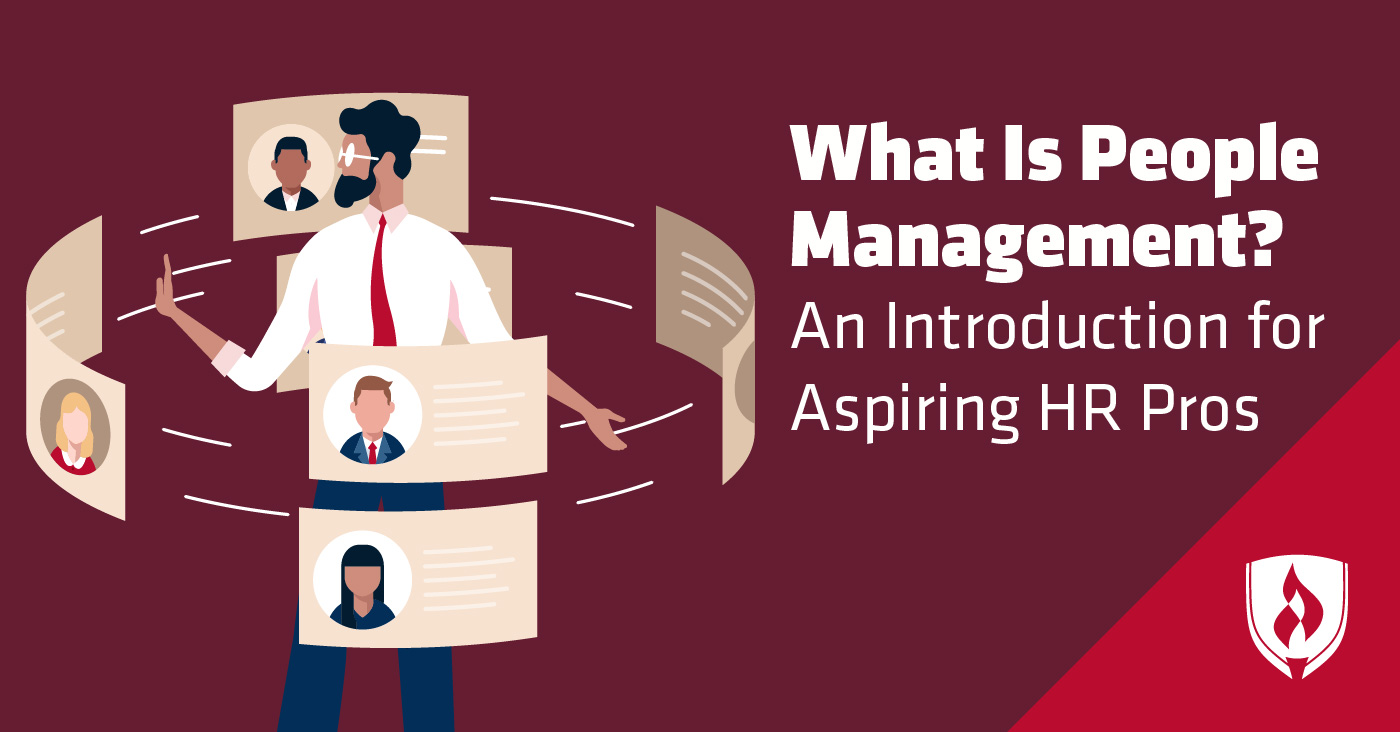
For many people, the human resources department at work may bring to mind navigating complex employee benefits offerings or the formal performance improvement plans their struggling coworkers have been put on. But you know that’s just a fraction of what HR is responsible for.
HR professionals work hard to find the right candidates for their organization and to improve the workplace for everyone. Human resource managers aren’t just creating job postings and handling payroll. Many of them are engaged in the rewarding work of people management.
What is people management? “If you are training, motivating or directing an employee, you're engaging in people management,” says Michael Alexis, CEO of Team Building. If your organization has a strong, positive work culture, it probably owes its success to people management.
Whether you’re an aspiring HR professional or you already have a human resources career, it’s worthwhile to understand the principles behind people management. Join us as we talk to human resources pros to learn the ins and outs of this HR approach.
What is people management?
“People management is a subset of human resource management,” Alexis explains. Many different HR activities fall under this umbrella, including talent acquisition, job training, listening sessions, motivation-mapping, conflict resolution, mentoring, employee appreciation and exit interviews.
The goal of people management is to make the work environment a better place for both employees and the organization itself. HR professionals who specialize in this area work with employees through their entire life cycle at the company, from hiring the right people for the job to helping them reach their full potential and working to keep them satisfied in their roles.
“Becoming stagnant in any career is a risk everyone faces, and with people management, you’re taking steps to prevent that before it even sets in so you can help someone find fulfillment in a greater goal,” says John Kohout, business development VP at Hudson Wealth Management. By developing strong people management, HR professionals are helping their teams stay motivated, productive and fulfilled.
The HR pros who excel at people management are those who have a blend of strong leadership and managerial qualities, according to Stan Kimer of Total Engagement Consulting by Kimer. Leadership skills are needed to “inspire each person to contribute their best to the organizational goal,” and solid managerial skills come in handy in “knowing how to assign tasks and track progress so the goal is achieved.”
Why is people management so important?
Since an organization is fueled by the people who put in their hard work for its success, it doesn’t come as a surprise that people management can affect nearly every facet of a company.
“People management makes the employees motivated, which helps to increase the productivity of the business,” says Jitesh Keswani, CEO of E-Intelligence. He adds that as employees feel more comfortable in their work environment, people management can also improve communication and team bonding in the workplace.
Beyond making sure employees are satisfied in their day-to-day work, people management also has larger implications for organizations. The workplace culture that’s developed through people management initiatives can shape an organization’s future reputation for years to come.
“If individuals have a positive experience through the recruitment process and as employees, that helps the company maintain a positive reputation and employee brand,” says Eric Mochnacz, HR consultant at Red Clover. No brand wants to leave their reputation up to chance. Implementing strong people management techniques is critical for organizations in every industry.
What elements are found in an organization with strong people management?
It’s clear that people management has a strong influence on the success of a company. It can’t be ignored! HR professionals use these principles to strengthen their organization’s people management.
Strong, proactive communication
Communication is the key to any relationship—and that’s no different for professional relationships. Organizations that encourage consistent communication, regular check-ins and are proactive about addressing employee concerns are on the right track.
“Often managers will wait until there is a problem to call a team meeting or check in with employees. By this time, it has often become a bigger issue than it needed to be,” Alexis says. “Instead, check in with your team often, especially when there is nothing wrong.”
Common goals
Teamwork is an integral part of people management. One way to improve this is to make sure that your organization’s goals are spelled out loud and clear so that everyone is moving in the same direction.
“Provide direction and goals to the team without micromanaging, and allow the team to share new ideas and approaches,” Keswani says.
Having clear, common goals for an organization helps put strategic decision making into focus and gives employees the latitude to figure out how to best accomplish these goals.
People-oriented leadership
This style of leadership focuses on what each individual brings to the table and supporting them in doing their best. It stands in contrast to micromanagers, who hover over their employees and are overbearing in their directions. “People-oriented management styles emphasize motivation, positive and productive communication, and teamwork,” Kohout says. “It can really energize an office—or any workplace, for that matter.”
Investments in manager training
People-oriented leadership doesn’t come naturally to everyone. Organizations should invest in regularly training their management teams to help them take the right approach. “Provide ongoing training and coaching to managers, especially those doing poorly, and don't be afraid to remove or demote poor managers,” Kimer says. “Reward the best managers, showcase them in the organization, and use them to train other managers.”
Balanced praise and criticism
No one wants to work somewhere where they’re constantly being criticized. Companies with a strong people management system make sure to balance critiques with praise. “Adhere to the 90-10 rule, giving your employees 90 percent praise and 10 percent critique,” Alexis says. “Of course, there will be times for constructive criticism, but it is important to keep it contained.”
Advocacy for employees
Some high-level executives become out of touch with what individual employees need and experience in their daily work. But organizations that forget to focus on their workers can derail their people management strategies. “HR professionals need to articulate that every decision a company makes has a direct impact on the organization's people,” Mochnacz says. “HR will need to advocate for the employees if an organization makes a decision that impacts the people.”
Make an impact in your workplace
People management is just one portion of the activities and initiatives fostered by an organization’s human resources team. Now that you know more about the role of HR within an organization, does this sound like it could be the career path for you?
Find out if it’s the right path for you in our article, “7 Surefire Signs You Should Be Working in HR.”




